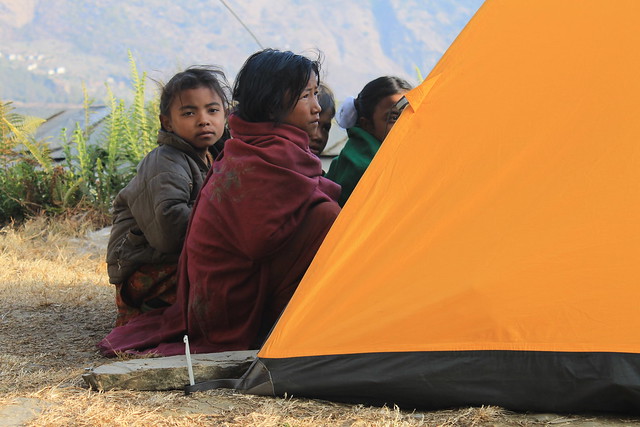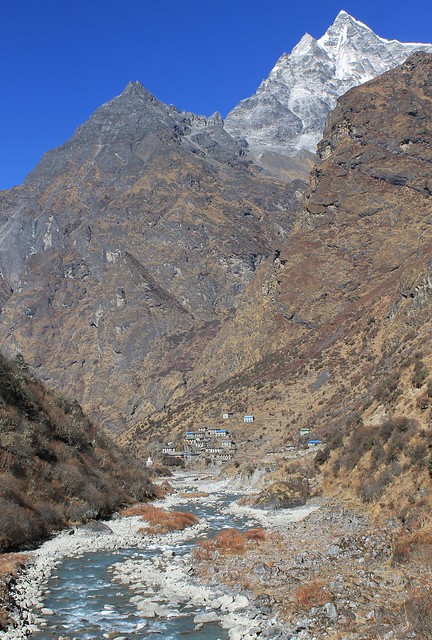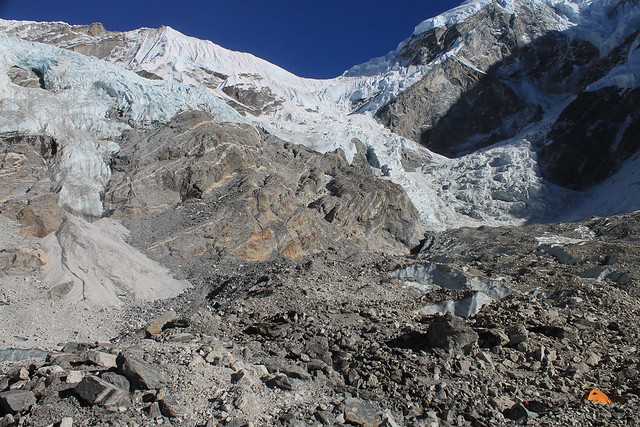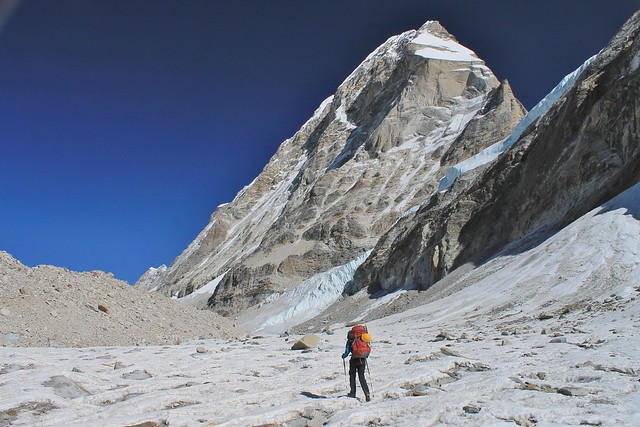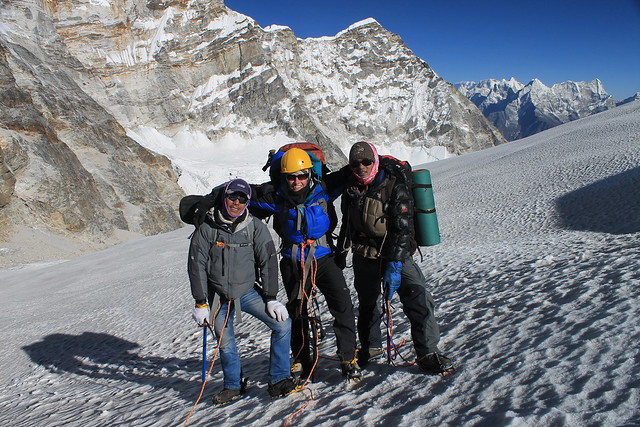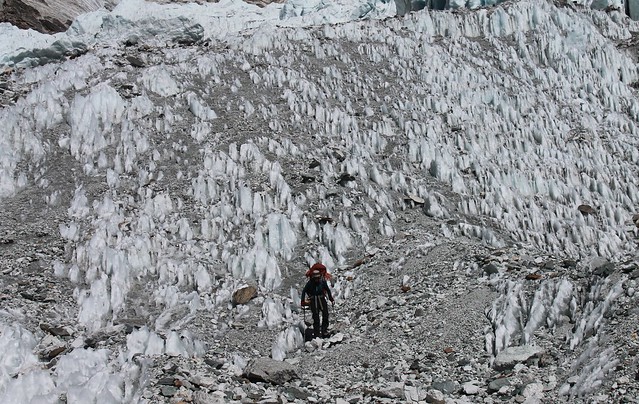As we traced fingers across maps, planning pre-departure routes from the comfort of our London flat, the Tashi Labsta pass was integral. It’s the most aesthetic route into Solu Khumbu from the west. No backtracking, no days of trudging up, over and down minor ridges in the mid-hills. Just a walk up the Rolwaling Valley, a few days on glaciers, a hop over the 5,760m pass, then a gentle descent to Namche. No big deal. It all sounded so easy as we relaxed on a sofa, cups of tea in hand.
Stats: Mandre to Namche Bazaar
Days – 12
Trekking days – 11
Distance – 149km
Trekking time – 50hrs
Amount climbed – 8,750m
Passes – 1 (Tashi Labsta – 5,768m)
Dal bhats – 9
Maggi – 7
Other gringo trekkers – 8
But we’d dismissed thoughts of attempting the route in light of the bone-chilling, finger-numbing cold of Dolpa in early November. Later, when Rolwaling plans began creeping back, we’d re-banished them when snow forced our retreat from the Ganja La. Tashi Labsta was far higher and we couldn’t get there until mid January, the Himalaya’s coldest month. We resigned ourselves to the long way round, consoling ourselves with recollections of melt-in-the-mouth apple pies to fuel our low-altitude progress.
But during our fortnight Christmas break in the comfort of Kathmandu and Pokhara the yearning to tread the high trail returned. It amazes (and always delights) us how quickly the mind tricks itself into forgetting the hardships of life in the mountains. Cold? Wind? Misery? Nah. Incredible panoramas, smiling people, the warmth of the morning sun – that’s all that’s up there, right?
But this time, along with the desire, came a nagging doubt. Tashi Labsta’s reputation intimidated us. Recent pictures we’d seen had us drooling. Huge peaks, wild glaciers, no teahouses, zero tourists.
‘But it’ll be mid-January.’
But it’s the perfect route into Solu Khumbu. We don’t want to go in via Jiri again.
But it’s the perfect route into Solu Khumbu. We don’t want to go in via Jiri again.
‘But it’ll be too cold.’
We’ll stock up on down.
We’ll stock up on down.
‘But -30C?’
We can survive that for a few nights.
We can survive that for a few nights.
‘But what about the rockfall? It’s bad at this time of year.’
We’ll take helmets.
We’ll take helmets.
‘And the freak storms?’
We’ve got a strong tent.
We’ve got a strong tent.
‘But what if we get lost?’
We’ll take guides.
We’ll take guides.
‘But, what if…….’
Sod it. It can’t be that bad. Let’s start asking around and see what information we can find.
Sod it. It can’t be that bad. Let’s start asking around and see what information we can find.
A theme soon emerged. Most we spoke to thought we were nuts to even think about Tashi Labsta in January. Not what we wanted to hear, we subconsciously dismissed this as scaremongering. A select few thought it should be possible, unless we were unlucky with the weather. But they, it always emerged in later discussions, had all climbed 8,000ers.
We remained undecided until a stroke of fortune helped make up our minds. In Thamel we met Nima Gombu Sherpa from Beding, the village nearest the pass. He could arrange for guides to meet us there. His brother was leaving Kathmandu for home the following day and could take 10kg of mountaineering kit for us – we could trek in with light bags. He thought we should be ok on the pass, as long as there wasn’t a storm.
Our minds were made up – we scurried off to pack. As we left his shop he handed us a business card. On the reverse was his climbing CV. Ama Dablam? Tick. Cho Oyu? Tick. Shishapangma? Tick. Everest 17 times? Tick.
The trip was all we’d hoped and feared. The scenery was magnificent; the sun was hot; there was no wind, except on pass day when the gusting gales knocked us off our feet; we camped in a balmy -18C; we watched our guides running from rockfall, transfixed by the slow motion drama of men sprinting from 200kph bullets and by the whizzing sound those bullets made (a moment as unforgettable as the first time we heard condors whirring past us in the Andes); after our guides left us, claiming the route to Namche was now obvious, we became lost and spent 2 hours going round in circles on a crevassed glacier; a boulder the size of Wales came loose as we slid on our arses down some ice, coming within 10m of mushing Neil to a pulp; we passed the corpse of a porter, wrapped in tarpaulin above the trail – a chilling reminder of the dangers of these forbidding mountains.
The cold, the wind, the rockfall. Was it all worth it? we wondered, after safely making it to trekking central and immersing ourselves in Namche’s creature comforts. But neither of us could really decide.
Are we glad we chose this route? You bet.
Would we cross Tashi Labsta again in January? No chance.
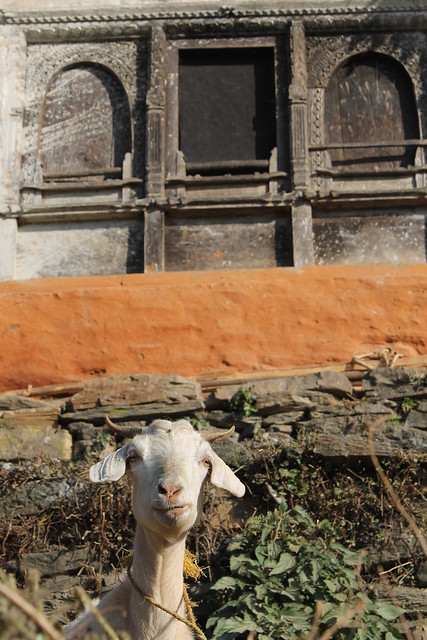 |
| Bonjour! In the lowlands before we started climbing up the Rolwaling Valley. |
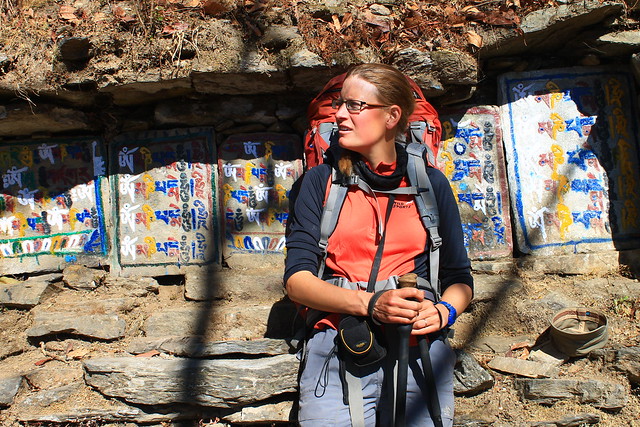 |
| Resting at a colourful chautara. |
 |
| Into the high stuff. This is at about 4,700m on the climb above Na. Tso Rolpa lake can just be seen above Haz’s head. |
 |
| On Trakording Glacier, nearing the end of a day we’d begun in Na. |
 |
| Still on Trakording Glacier. Going from cairn to cairn the trail here was not too hard to follow even though we suspect that no one had come this way for weeks. |
 |
| Alien feet at Tashi Labsta high camp. It wasn’t as cold as we feared it might be at this 5,700m camp site, still, with no down booties our down mitts came in handy while we melted ice for tea. |
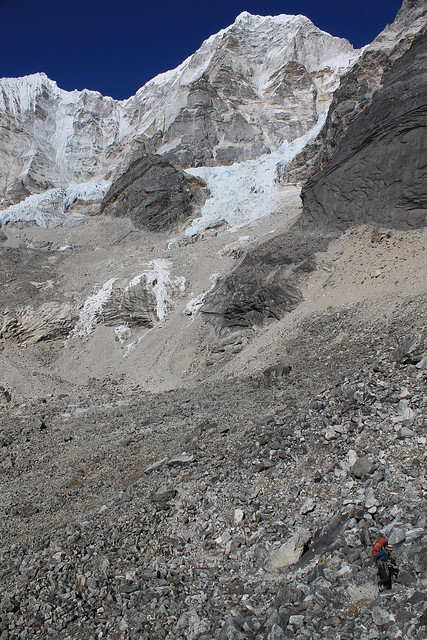 |
| Back on a nice trail. After Ngole camp the trail was clear and easy to follow, so we made it down to Thame by mid afternoon. |
Stats: Mandre to Namche Bazaar
Days – 12
Trekking days – 11
Distance – 149km
Trekking time – 50hrs
Amount climbed – 8,750m
Passes – 1 (Tashi Labsta – 5,768m)
Dal bhats – 9
Maggi – 7
Other gringo trekkers – 8
